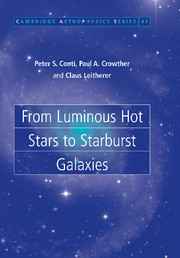Book contents
- Frontmatter
- Contents
- Preface
- Acknowledgements
- 1 Introduction
- 2 Observed properties
- 3 Stellar atmospheres
- 4 Stellar winds
- 5 Evolution of single stars
- 6 Binaries
- 7 Birth of massive stars and star clusters
- 8 The interstellar environment
- 9 From giant HII regions to HII galaxies
- 10 Starburst phenomena
- 11 Cosmological implications
- References
- Acronyms
- Symbols
- Object index
- Subject index
9 - From giant HII regions to HII galaxies
Published online by Cambridge University Press: 28 October 2009
- Frontmatter
- Contents
- Preface
- Acknowledgements
- 1 Introduction
- 2 Observed properties
- 3 Stellar atmospheres
- 4 Stellar winds
- 5 Evolution of single stars
- 6 Binaries
- 7 Birth of massive stars and star clusters
- 8 The interstellar environment
- 9 From giant HII regions to HII galaxies
- 10 Starburst phenomena
- 11 Cosmological implications
- References
- Acronyms
- Symbols
- Object index
- Subject index
Summary
Giant HII regions are extensive regions of ionized hydrogen (and other elements) powered by hot stars. Their high concentration of very massive stars often makes them appear as the optically most luminous structures in galaxies. Nearby giant HII regions allow us to study star formation and evolution in great detail and help us understand unresolved giant HII regions in distant galaxies.
Giant HII regions: definition and structural parameters
In this section we will concentrate on the properties of giant HII regions, such as the famous 30 Doradus nebula in the LMC. The focus of this book is on hot, massive stars, and we are interested in HII regions because their properties allow us to learn about the stars powering them. As opposed to smaller, Orion-like HII regions, giant HII regions are sufficiently rich in O stars that the entire upper end of the mass spectrum is sampled and an unbiased view of the hot-star population can be obtained.
Giant HII regions are among the most conspicuous objects in nearby late-type galaxies, in particular when observed in narrow emission lines, such as Hα. Systematic studies of nearby giant HII regions such as that by Kennicutt (1984) have established their fundamental properties. These HII regions typically have diameters of 100 pc or larger, densities of a few particles per cm3, and ionized gas masses of order 105M⊙. In Fig. 9.1 we show a well-known example, NGC 604 in the Triangle galaxy M33.
- Type
- Chapter
- Information
- From Luminous Hot Stars to Starburst Galaxies , pp. 197 - 228Publisher: Cambridge University PressPrint publication year: 2008

